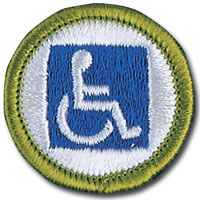 Click here for the official guidelines from the Boy Scouts of America for the Disabilities Awareness Merit Badge.
Click here for the official guidelines from the Boy Scouts of America for the Disabilities Awareness Merit Badge.
KPS4Parents, the developers of the Learn & Grow Educational Series, began in 2003 as a child and parent advocacy organization devoted to children with disabilities and their families. We have worked extensively in the fields of special education and disability civil rights. As such, we are in a position to assist Scouts in their pursuit of the Disability Awareness Merit Badge regardless of whether they choose to participate in our self-watering container gardening projects, or not. The content provided in support of this badge is not specific to self-watering container gardening, but it is specific to our organization’s continuing dedication to advocating for the educational and civil rights of students with disabilities to be honored.
This badge requires you to discuss with your counselor proper disability etiquette and person-first language. These are very important concepts for you to understand. People are people first, regardless of where they come from, what they look like, or how they live. Souls are souls and bodies are bodies; which body a soul gets does not determine the value of the soul, or at least this is the underlying ethical construct that KPS4Parents relies upon to conceptualize person-first language. There are no autistic children, for example, only children who have autism. They are children first. Their disabilities do not define their value or set them apart as a species separate from the rest of humanity. All people, regardless of whether they have disabilities or not, are brothers and sisters to each other.
It has been said that the rights of those challenged by disability are the last to be recognized. Mental illness is still treated by most of American society as a character flaw worthy of criminal prosecution and incarceration rather than a health condition deserving of treatment. People are punished for manifesting symptoms of these kinds of disabilities rather than provided with proper medical and mental health treatment.
The Civil Rights Movement of the 1960s sought racial equality. The Sexual Revolution of the 1970s sought equality among men and women in society and the workplace, and we continued to struggle with these concepts through the 1980s and 1990s, with many of the disparities addressed as of today, though not all. The next demographic segment to assert its rights was that of the LBGQT community, a movement that started to gain some traction in the 1980s and culminated in a Supreme Court decision in 2013 that protects the rights of same-sex couples to marry. While this is a fairly recent development and American culture is still in the process of assimilating these changes, it is another civil rights milestone achieved.
Overcoming the negative reactions that so many people in American society still have to those with disabilities remains a challenge. Misinformation about various conditions and how they affect people, as well as how programs to help them are funded relative to programs intended to serve other populations fuels feuds and disputes over what assistance people with disabilities should and do receive from taxpayer-supported resources.
This badge requires you to visit an agency that works with people with physical, mental, emotional, or educational disabilities. KPS4Parents fits that description in every regard. However, we are a virtual organization with no public walk-in office at this time. By visiting our site, you are visiting us. Plus, we are happy to speak with you by phone or via email about any of the things this badge requires you to do to the degree that we are able.
One option for this badge is to speak to someone who has a disability and learn about this person’s experiences and activities. KPS4Parents has been representing students with disabilities since 2003 and many of these students have graduated from high school and go on to college and/or careers. Several have made themselves available to speak with others regarding their experiences and KPS4Parents is happy to coordinate introductions should Scouts working on this badge need someone with a disability to interview but don’t know of anyone they could interview in their local area.
Another option is to learn how people with disabilities take part in a particular adaptive sport or recreational activity. For older Scouts, one option (with parent and counselor permission, of course) is the movie Murderball, which is about athletes with partial quadriplegia who participate in a full-contact adaptation of rugby and compete at the World Paralympic Games. This is a brutally honest documentary that doesn’t sugarcoat the issues, including the violent nature of many of the athletes’ injuries that lead to their quadriplegia, sexuality, and other very personal details; it is strongly suggested that parents and counselors watch the movie first to determine its suitability for their Scouts. However, the story it tells regarding the human will to apply effort in the pursuit of achievement in spite of significant physical impairment in an aggressive, full-contact sport is unparalleled.
Yet another option is to learn about independent living aids and assistive technologies. If you are a public school student, you should be able to speak with the school psychologist assigned to your school about assistive technology assessments for special education purposes and introduce you to the people who conduct assistive technology assessments for special education students in your school.
Assistive technology assessments in special education are meant to determine how different low- to high-tech solutions can be used to help special education students achieve the measurable annual goals in their Individualized Education Plans (IEPs). The measurable annual goals target the specific things these students need to be taught over the course of a year and how their progress will be measured so that it can be known whether they met the goals and, if so, how much of an increase in learning they experienced. Services and supports, including assistive technology, are used to help students meet their goals. In fact, services and supports are chosen specifically based on how they can be used to support the IEP goals.
The only way to really figure whether a particular piece of technology will support a student’s pursuit of his/her goals is to have him/her try it out and see how it works. The assessor watches and helps to see if the student can use the technology to work towards his/her IEP goals. If he/she can, then the student’s IEP team, which includes his/her parents and educators, then decides whether or not it should be added to the student’s IEP. If it gets added to the IEP, then the school must provide it to help the student meet his/her goals and be successful in school. This process is regulated by a federal law called the Individuals with Disabilities Education Act (IDEA).
This badge also asks you to explain what advocacy is. It then gives you the option to put on a presentation about disabilities awareness, volunteer with an advocacy organization for eight hours, or list 10 myths and misconceptions about people with disabilities and the facts about each myth. Whether you need information for a presentation, want to volunteer for eight hours with our non-profit advocacy organization, or compile a list, we are here to support your work towards these components of this badge. Please use our Contact Us for to reach out to us regarding this badge. This is an issue dear to our hearts and we are here to help you gather reliable facts about disabilities.
Return to Boy Scouts Page
